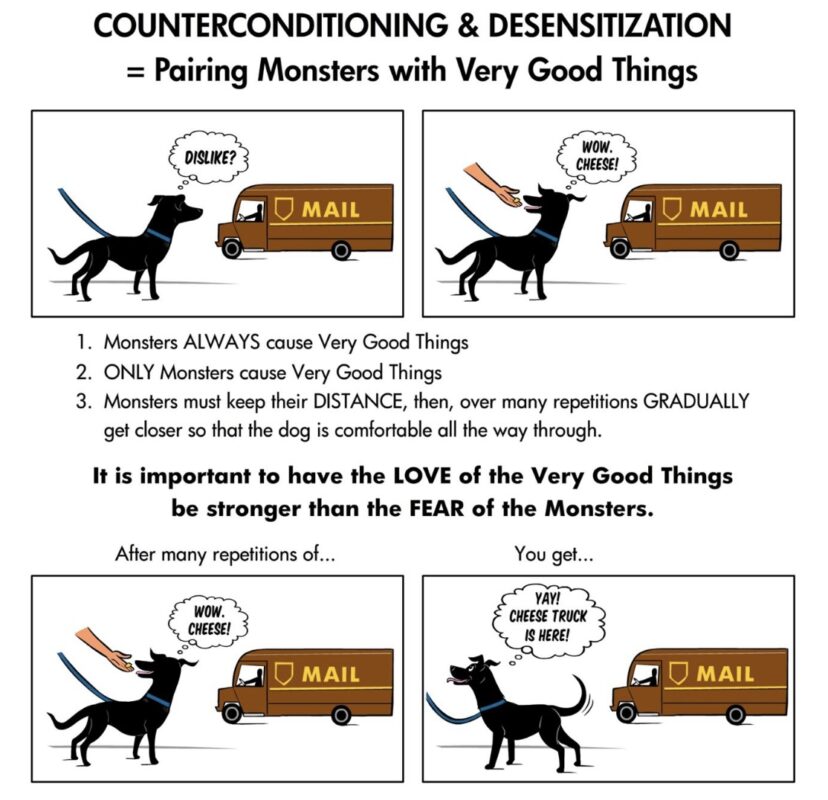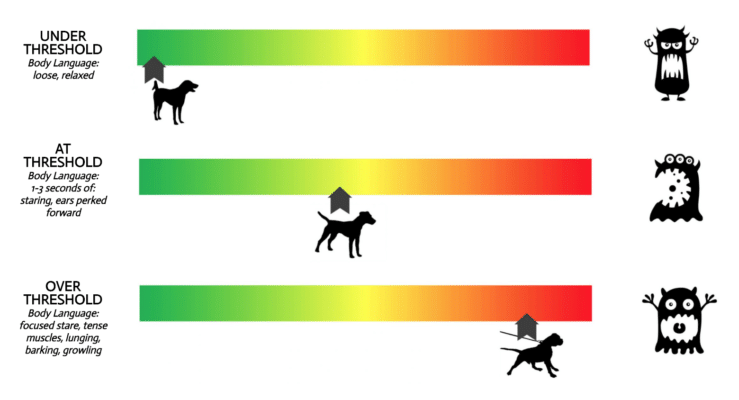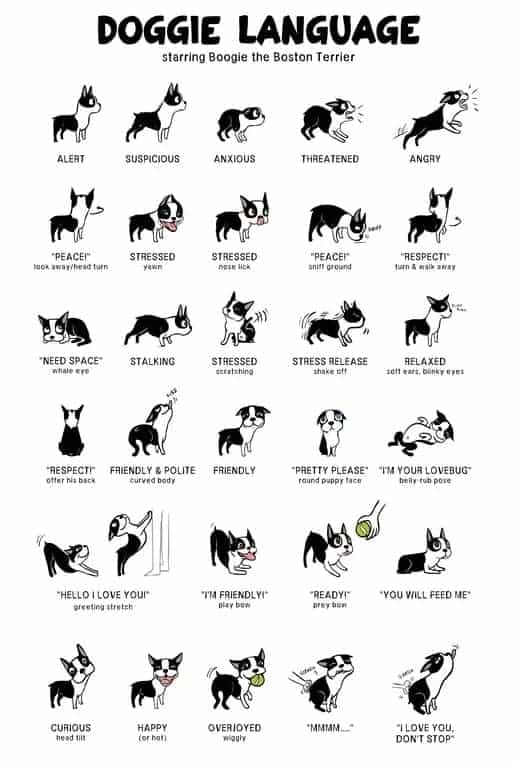behavior modification, Canine Body Language, counter-conditioning and desensitization, Dog Aggression, dog anxiety, dog fears, Threshold
Understanding Thresholds and Canine Body Language : The Key to Successful Counterconditioning and Desensitization
Understanding Thresholds and Canine Body Language: The Key to Successful Counterconditioning and Desensitization by Will Bangura, M.S., CBCC-KA, CPDT-KA, (Dog Behaviorist) Certified Behavior Consultant
If you have a dog with anxiety, fear, phobias, reactivity, or aggression, changing these emotional states and their corresponding behaviors is through a behavior modification process known as counterconditioning and desensitization (D/CC.) To successfully implement (D/CC) counterconditioning and desensitization to help dogs with fears, anxiety, or aggression, it is critical to have an in-depth understanding of canine body language and thresholds.
What is Counterconditioning?
Counterconditioning is a technique used in dog training to modify a dog’s emotional response to a specific stimulus, such as a trigger that causes fear, aggression, or anxiety. Counterconditioning aims to replace a negative emotional response with a positive one by associating the trigger with something pleasant or rewarding.
Counterconditioning works by creating new positive associations with the trigger. The process involves exposing the dog to the trigger in a controlled and gradual manner while simultaneously providing the dog with a positive experience. This positive experience could be through treats, toys, play, or praise.
For example, let’s say a dog is afraid of loud noises such as thunderstorms. To counter condition the dog’s fear, the trainer would gradually expose the dog to the sound of thunder while providing positive reinforcement, such as treats or playtime. Over time, the dog would learn to associate the sound of thunder with positive experiences, and the fear response would gradually diminish.
Counterconditioning can also be used to modify aggressive behavior in dogs. For instance, if a dog is aggressive towards other dogs, the trainer would expose the dog to other dogs while providing a positive experience, such as treats or play. Over time, the dog would learn to associate other dogs with positive experiences, and the aggressive behavior would diminish.
Counterconditioning is often used with desensitization, which involves gradually exposing the dog to the trigger in a controlled and safe manner to reduce the intensity of the dog’s response. Together, these techniques can be highly effective in modifying a dog’s behavior.
What is Desensitization?
Gradual and systematic desensitization is a technique used in dog training to help a dog overcome a fear or phobia by gradually exposing the dog to the trigger in a controlled and safe manner. This technique is often used with counterconditioning to help the dog develop positive associations with the trigger. By breaking down the trigger into small, manageable steps and keeping the dog below threshold, trainers can help dogs overcome their fears and anxieties and improve their behavior.
The desensitization process involves breaking down the trigger into small, manageable steps that the dog can handle without becoming fearful or anxious. For example, if a dog is afraid of strangers, the trainer would start by exposing the dog to a stranger at a distance where the dog is comfortable and relaxed and then gradually move closer over time.
The key to successful desensitization is to keep the dog below threshold at all times. This means the dog should never become so anxious or fearful that it cannot learn or respond to training. If the dog becomes too anxious or fearful, the trainer must go back to a previous step and proceed more slowly.
Desensitization is often used with counterconditioning, which involves pairing the trigger with something positive or rewarding to help the dog develop positive associations with the trigger.
For example, if a dog is afraid of thunderstorms, the trainer would start by exposing the dog to a low-level recording of thunder while providing the dog with a positive experience, such as treats or play. Over time, the sound’s intensity gradually increased until the dog was no longer afraid of thunderstorms.
Similarly, if a dog is aggressive towards other dogs, the trainer would start by exposing the dog to other dogs at a distance where the dog is comfortable and relaxed while providing positive reinforcement, such as treats or play. Over time, the distance would gradually decrease until the dog can be around other dogs without becoming aggressive.
What is Threshold?
Threshold refers to the level of stimulation or stresses a dog can handle before they become overwhelmed and exhibit a stress response. This can include shaking, panting, pacing, or growling. For dogs with fears, anxiety, phobias, reactivity, and aggression, it’s crucial to understand their threshold levels to help them stay calm and reduce their stress response.
Threshold in dogs refers to the point at which a dog’s behavior changes from calm and relaxed to fearful, anxious, or aggressive. It is essential to understand this because when working with dogs with fears, phobias, or aggression, the goal is to keep them below threshold during training. Going over the threshold can make the dog more fearful, anxious, or aggressive and undo any progress made during training.
Thresholds can vary from dog to dog and situation to situation, depending on breed, age, training, and socialization factors. It’s important to remember that thresholds can change over time and can be influenced by many factors.
Understanding Threshold Levels Through Canine Body Language Cues.
To determine a dog’s threshold, paying close attention to its body language is important. Dogs communicate through body language, and they often display subtle signals that can indicate their level of stress or arousal. You can better understand when a dog approaches or exceeds their threshold by learning to recognize these signals.
One of the most crucial skills is reading and understanding canine body language. This skill becomes even more critical when working with dogs with fears, phobias, or aggression. The use of counterconditioning and desensitization (D/CC) is an effective approach to help dogs overcome these challenges. However, to be successful, it is essential to recognize when a dog is at or over threshold if you want to change a dog’s fearful, anxious, reactive, or aggressive behavior.
One of the challenges in working with dogs is that they cannot speak to us, and their body language is their primary means of communication. However, many people are unfamiliar with the subtle cues dogs give off to indicate they are stressed, fearful, or anxious. It is crucial to be able to read these cues to prevent going over threshold and to ensure the safety of everyone involved.
Some more obvious signs of stress in dogs include panting, yawning, trembling, tail tucked, hair raised, and pacing. However, many subtle cues can indicate a dog is stressed, and handlers often miss them.
Dogs can exhibit various stress signals that can be subtle and difficult to notice, especially if you’re not familiar with their body language. Here are some of the more subtle and difficult-to-see stress signals in canine body language:
Canine Body Language Signals.
- Lip licking: Dogs often lick their lips when feeling stressed or anxious. This behavior can be subtle and easy to miss, especially if your dog doesn’t do it often.
- Yawning: Dogs may yawn when they’re feeling stressed or nervous. It may be a sign of stress if your dog yawns frequently or at inappropriate times.
- Half-moon eyes: This is when a dog’s eyes appear to be partially closed, with the whites of their eyes showing. This can be a subtle indication of anxiety or discomfort.
- Shaking off: Dogs may shake off as if trying to dry themselves, even if they’re not wet. This can be a way for them to release tension and stress.
- Freezing: Dogs may suddenly freeze in place, especially if feeling threatened or uncomfortable. This behavior can be subtle and easy to miss, especially if your dog briefly freezes.
- Tail carriage: Dogs often hold their tails in different positions depending on their mood. A tucked tail or a low tail carriage can signify stress or anxiety.
- Avoidance: Dogs may avoid eye contact, turn away from people or other dogs, or hide when they feel stressed or uncomfortable.
- Pupil dilation: When a dog is stressed or anxious, their pupils may dilate. This can be a subtle signal, especially in dogs with dark eyes.
- Facial muscles: Dogs may tense or relax their facial muscles depending on their mood. A tense, tight-lipped expression can signify stress, while a relaxed, loose-lipped expression can indicate that the dog feels more comfortable.
- Ears Dogs may hold their ears in different positions depending on their feelings. A dog with ears held back or flat against their head may be feeling anxious or afraid.
- Paw lift: Dogs may lift one paw off the ground when feeling stressed or uncertain. This can be a subtle signal that they’re feeling uncomfortable.
- Mouth open or closed: A dog with a closed mouth may be feeling tense or stressed, while a relaxed, open mouth can indicate that they’re feeling more comfortable.
Shallow breathing versus deep breathing: When a dog is stressed or anxious, it may become shallow and rapid. This can be a subtle sign that they’re feeling uncomfortable.
Pay attention to your dog’s body language and behavior to identify subtle signals indicating stress or anxiety. Doing so can help your dog feel more comfortable and relaxed in their environment.
Handlers should also pay attention to their dog’s overall body posture. A stressed or fearful dog may hunch their back, lower their head, or cower.
Handlers can also use the dog’s body language to determine if they are at or over threshold. One example is when a dog’s behavior changes, such as when they start to bark, growl, or lunge. This is an obvious sign that the dog is over threshold and should be removed from the situation.
Another sign that a dog may be over threshold is when they stop taking treats. Dogs that are stressed, anxious, or fearful may refuse treats, even if they are their favorite food. Handlers should be aware of this and adjust the training accordingly.
It is also essential to note that some dogs may appear calm on the outside, even if they are over threshold. These dogs may show very subtle signs of stress, such as tensing their muscles or holding their breath. It takes experience and practice to recognize these subtle cues, but it is crucial to do so to ensure the safety and success of the training.
It is also important to note that every dog is different, and what may work for one may not work for another. Handlers must take the time to learn their dog’s body language and behavior patterns to ensure a successful training outcome. It is also essential to consult with a professional dog trainer or behaviorist if you are unsure how to proceed with the training process.
Here is a more comprehensive list of canine body language signals to learn:
Dog Stress Signals:
- Yawning – Dogs may yawn excessively when feeling stressed.
- Panting – Heavy panting can indicate stress or anxiety in dogs.
- Lip Licking – Dogs may lick their lips when feeling stressed or uncomfortable.
- Whining – Dogs may whine when they are feeling anxious or stressed.
- Dilated Pupils – A dog’s pupils may become dilated when feeling stressed or fearful.
- Excessive Shedding – Dogs may shed more than usual when feeling stressed or anxious.
- Tail Tucked Between Legs – When a dog tucks their tail between their legs, it may indicate that they are feeling scared or stressed.
- Shaking or Trembling – Dogs may shake or tremble when feeling anxious or stressed.
- Pacing – Dogs pacing back and forth can indicate feeling stressed.
- Hiding – Dogs may hide or seek out a safe space when they are feeling stressed or anxious.
Displacement Behaviors and Calming Signals:
- Licking their nose or lips – Dogs may lick their nose or lips as a calming signal to communicate that they are not a threat.
- Turning their head away – Dogs may turn their head away from someone or something, causing them stress or discomfort.
- Shaking off – Dogs may shake their body to release tension or stress.
- Scratching – Dogs may scratch themselves as a displacement behavior when feeling stressed.
- Sniffing – Dogs may sniff the ground or air to diffuse stress.
- Sitting or Lying Down – Dogs may sit or lie down when feeling stressed or uncomfortable to calm themselves down.
- Stretching – Dogs may stretch as a displacement behavior to relieve stress or tension.
Distance Increasing Signals:
- Growling – Dogs may growl to increase the distance between themselves and a perceived threat.
- Baring Teeth – When dogs show their teeth, it can signify that they want to increase the distance between themselves and a perceived threat.
- Snapping – Dogs may snap at someone or something to communicate that they want more space.
- Stiff Body Posture – When a dog’s body is stiff and tense, it can signify that they want more distance from a perceived threat.
- Raised Hackles – When a dog’s hackles (the fur along its spine) are raised, it can be a sign that they feel threatened and want more distance.
Distance Decreasing Signals:
- Tail Wagging – Dogs may wag their tail to communicate that they want to decrease the distance between themselves and another dog or person.
- Play Bow – When a dog does a play bow (front end down, rear end up), it can be a sign that they want to decrease the distance and engage in play.
- Licking or Nudging – Dogs may lick or nudge someone to communicate that they want to decrease the distance and engage in friendly interaction.
Canine Body Language Signals in Play:
- Loose, Relaxed Body Posture – Dogs may have a loose and relaxed body posture when playing and having fun.
- Play Bow – Dogs may do a play bow (front end down, rear end up) to signal that they want to engage in play.
- Mouth Open and Tongue Out – When dogs have their mouth open and tongues out, it can signify that they enjoy themselves during play.
- Quick Movements – Dogs may make quick, darting movements during play to signal that they are having fun and want to continue playing.
- Soft, Playful Barks – Dogs may emit soft, playful barks during play to signal their enjoyment.
- Tail Wagging – Dogs may wag their tail during play to signal that they are having fun.
- Playful Nipping or Mouthing – Dogs may gently nip or mouth during play to engage with their playmate.
It’s important to note that these signals are not always clear-cut and can vary depending on the individual dog and the context. It’s also important to consider these signals in conjunction with other body language cues to better understand how a dog feels. Understanding canine body language can help you communicate and build a strong relationship with your dog.
Understanding canine body language and thresholds is crucial when using counterconditioning and desensitization to help dogs overcome fears, phobias, or aggression. Handlers must recognize when a dog is at or over threshold, even if they appear calm outside. Reading a dog’s emotional state through its body language is critical to the success of the training and the safety of everyone involved. By learning and understanding canine body language, handlers can build trust with their dogs and create a positive training environment that leads to success.
Video Podcast from June 12th, 2023, on Counter-Conditioning and Desensitization
“The Worlds Beast Calming Aid for Dog Anxiety or It’s Free!”
References.
- Turid Rugaas. “On Talking Terms with Dogs: Calming Signals.” Dogwise Publishing, 2006. Brenda Aloff. “Canine Body Language: A Photographic Guide Interpreting the Native Language of the Domestic Dog.” Dogwise Publishing, 2005.Sarah Kalnajs. “Am I Safe? Creating and Maintaining a Safe Zone.” Blue Dog Training & Behavior LLC, 2008.
- Suzanne Clothier. “Bones Would Rain from the Sky: Deepening Our Relationships with Dogs.” Grand Central Publishing, 2005.
- Karen Pryor. “Don’t Shoot the Dog: The New Art of Teaching and Training.” Bantam Books, 1999.
- Yin, Sophia. “Low Stress Handling, Restraint and Behavior Modification of Dogs & Cats: Techniques for Developing Patients Who Love Their Visits.” Cattledog Publishing, 2009.
- Borchelt, Peter. “Aggression in Dogs: Practical Management, Prevention & Behaviour Modification.” John Wiley & Sons, 2017.
- Blackwell, Emily J., Rachel A. Casey, and Natalie J. Wills. “The use of counter-conditioning and desensitization techniques to modify the fear response in dogs: a systematic review.” Journal of Veterinary Behavior, vol. 3, no. 3, 2008, pp. 152-162.
- Martin, Debbie. “Desensitization and Counterconditioning: How to Change Your Dog’s Emotional Response to a Stimulus.” Whole Dog Journal, vol. 16, no. 1, 2013, pp. 10-12.





